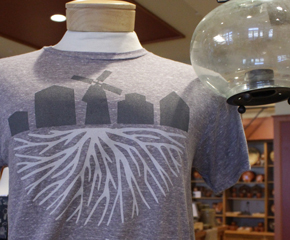
Reinventing the Rouge
Henry Ford located the Rouge Complex strategically for its access to waterways and the transportation network. He had the swampy site turned into a massive industrial complex by driving hundreds of wood pilings into the ground to support the buildings. The Rouge was transformed from wetlands to the mightiest industrial complex ever known. And that transformation made a lasting impact, both good and challenging, eventually creating a huge brownfield pollution site.
When Ford Motor Co. Executive Chairman Bill Ford Jr. re-envisioned the Rouge, he was influenced by the pioneering environmental work of architect Bill McDonough. Together, they saw a site that could become healthy again over time. A home for birds and bees and thousands of trees. A site that could be a model of industrial production and environmental redesign.
McDonough guided transformation of the site at every level. The massive project involved reworking major portions of the 70-year-old site, including building the Dearborn Truck Plant and Visitor Center from the ground up. Site design included a natural approach to storm water management, landscaping and the surrounding wildlife as well as the installation of phytoremediation beds to deal with existing brownfield pollution.
All manufacturing processes at the plant were designed to minimize waste at all stages. Parts are delivered in reusable bins whenever possible, all paper and cardboard excess is recycled, and waste gases at the paint plant are captured and turned into fuel cells to help power the plant itself. The stamping process was redesigned to collect all excess aluminum such as the cut-out for the windshield, shred that excess material and immediately return it for reuse by the aluminum manufacturers. In the Dearborn Truck Plant, ceiling-mounted light boxes and monitors flood the manufacturing floor with natural light. This innovative daylighting system, together with tempered air, more space, and ergonomics applied to every task, have greatly changed workers’ daily experience.
Today’s Rouge features a Gold LEED Visitor Center, treats its storm water with an all-natural system that includes one of the world’s largest “living roofs,” has a paint plant that captures fumes to create fuel cells, has plants treating decades of soil pollution, is a better neighbor and a better place to work, and is now home to wildlife.
Ford is proving that environmentally sound manufacturing processes can, in fact, be profitable. Ford’s approach is showing that sustainable design is high-performance design that can:
- Lower annual energy costs
- Lower long-term maintenance costs
- Use non-toxic, easily recycled materials
- Create healthier work environments
- Improve employee productivity
- Attract talented recruits
- Improve market image
- Help protect the environment
Creating Natural Storm Water Management
In cities across America, storm water systems channel rainwater and snowmelt into drains and sewers. The sudden rush of water scours dust and dirt from paved surfaces, sending dirty water into nearby rivers and lakes.
By contrast, rain and snow at the Ford Rouge Center falls on acres of soft surfaces like the Living Roof, where storm water is captured and cleansed. And as large as it is, the 10.4-acre living roof is just one part of an extensive, natural storm water management system surrounding the Dearborn Truck Plant.
The system captures and cleans runoff before returning it to the watershed using natural processes, not chemicals. It also helps protect against flooding. An integrated system, it includes the Living Roof, natural treatment wetlands, vegetated ditches called swales, hundreds of newly planted trees, and the world’s largest porous pavement lot located northwest of the Dearborn Truck Plant.
Rain falling on the Living Roof is absorbed or filtered by sedum plants. Excess water drains off the roof into stone storage basins located under an innovative and absorbent porous parking lot nearby. Water then flows into swales and treatment wetlands where plants act as "nature’s filters" to help prevent dust and dirt from migrating into rivers and lakes.
A natural system like this one has the potential to save millions of dollars compared to installing and operating a traditional storm water treatment plant.
Using Plants to Restore Healthy Soils
Ford is experimenting with a biological process called phytoremediation to remove PAH compounds from soil near the old Rouge coke ovens. PAH compounds are polyaromatic hydrocarbons, a by-product of decades of steel manufacturing.

Phytoremediation uses plants, and the microbes attracted to their roots, to break down contaminants into harmless organic compounds which are absorbed into the roots. This process helps rid the soil of PAH compounds. It also filters storm water runoff, regenerates wildlife habitat, and beautifies the landscape.
The phytoremediation test site at the Rouge represents one of the world’s most ambitious studies of this process. Compared to conventional cleanup methods, phytoremediation:
- Is more environmentally beneficial than removing impacted soil and hauling it to a landfill, which merely moves the problem from one site to another
- Can cost less than excavating and landfilling
- Is solar-energy-driven
- Adds beauty to the landscape through use of native plants including prairie dock, cardinal flower, New England aster and other perennials that clean soil
- Restores wildlife habitats
Bringing in Lots of Daylight and Fresh Air
Natural processes are revitalizing the environment outside the Ford Rouge Center. They also are being used inside the final assembly building to make it a more desirable place to work.
The building’s design considers the needs of people—as well as machinery—a legacy handed down from Henry Ford and architect Albert Kahn.
Compared to the old assembly plant, the change is dramatic. Ten huge skylights called monitors—each one nearly 3,000 square feet—and 36 smaller skylights fill the building with natural light. Energy-efficient glass reduces glare and heat from the sun. On sunny days, the skylights allow up to half the building’s lights to be turned off. This reduces electrical energy usage. Using natural light also improves color perception, reduces eyestrain, and improves mood. According to researchers, people who work in natural light are more productive.
And, because poorly ventilated buildings can induce fatigue, the plant is heated and cooled by an innovative “big foot” air tempering system that replaces air in the building with fresh air every 30 minutes. This ductless system mixes warm air near the ceiling with cool air near the floor to create a more pleasant temperature at work level. The building itself acts as one giant air duct, creating a slightly positive air pressure that keeps out drafts when loading dock doors open. The system includes a one-million-gallon thermal water storage tank. During the summer, chilled water in the tank cools the building more efficiently and cost-effectively than using oversized mechanical equipment. Employees will see and feel better in this comfortable working environment.
Learn more:


